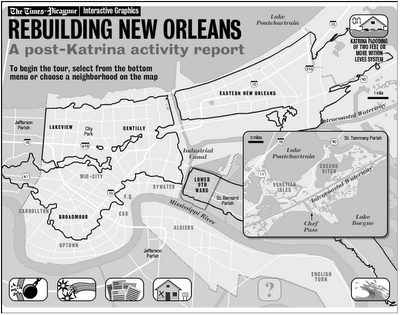A lush green turf carpets the floor. Plush black leather seats fill the club sections. Bright gray and blue paint shines on the walls. Glitzy 42-inch flat-screen televisions hang from the walls of the luxury suites.
While a flurry of work continues around the clock, the first phase of the $185 million renovation of the Superdome is essentially complete. Minor repairs are all that's left before the iconic 31-year-old stadium reopens to an international audience Sept. 25 when the Saints return home to play the Atlanta Falcons on "Monday Night Football."
Hurricane Katrina ravaged the stadium, causing millions of dollars in wind and water damage to the roof and interior. The facility sustained further damage when it served as a shelter for more than 20,000 storm victims in the week after the hurricane.
"We're ready to play football," said Doug Thornton, the regional vice president of SMG, the company that manages the Superdome.
That's not to say the work is finished. But the major jobs in the multiphase project have been completed in recent weeks. All that remains, Thornton said, are "little strokes."
Workers still need to spray sand and rubber fill into the artificial turf playing field. That work is expected to be completed by early next week.
Technicians also need to program the scoreboards and video boards. Italian porcelain tile and temporary carpet needs to be laid in the building's upper-level concourses and lobbies. Menu boards and graphics must be installed in the concession stands. And about 20 percent of the light fixtures still need new lamps.
Otherwise, the Dome is good to go. In fact, Thornton said the construction is farther along than originally anticipated. Workers have already started to install countertops and cabinetry in some of the stadium's 137 luxury suites, a job that originally fell under a later work timeline.
"I am not worried about anything," Thornton said. "A week is a lifetime in the construction business."
Thornton led several members of the Louisiana Stadium and Exposition District board of commissioners on a tour of the building Wednesday afternoon, and the group left the building impressed
"It looks much better than I expected," Commissioner Craig Saporito said.
"I'm loving this," said Commissioner Sara Roberts.
So far, Thornton said, the six-month project has avoided any major setbacks during final testing of the building's operating systems.
A test performed last week by environmental engineers for the state indicated that air quality inside the facility is excellent.
Tests continue on the video board, scoreboard and message board system, which includes two new 27-by-48-foot video displays in the end zones, four high-tech 8-by-44-foot scoreboards in the corner of each end zone and four new 183-foot-long LED halo boards along the facade of the loge level. All the equipment has been mounted and wired.
Similar tests will be conducted on the lighting and public address systems in the next few days.
One of the final tests will be a "super flush" of the plumbing system. The test, which consists of hundreds of workers simultaneously flushing toilets throughout the building, was scheduled for Wednesday night or this morning.
Thornton said all the work and testing needs to be completed by Wednesday so he and other officials have time to conduct a thorough evaluation of the building.
The Saints are expected to hold their first practice in the Dome on Sept. 21 to familiarize themselves with the building. More than half of the players on the 53-man roster have never played in the stadium.
Complicating matters is the planning for the opening event itself. Dome officials compared the game to a Super Bowl in terms of planning and preparation. For example, leading up to the game, ESPN is expected to broadcast many of its daily shows live from the footbridge between the Superdome and New Orleans Arena.
As part of the NFL game-day events, the Goo Goo Dolls will conduct a live show outside the stadium. Bono, the lead singer for U2, is expected to perform for the Dome crowd before the game.
Gov. Kathleen Blanco, former NFL Commissioner Paul Tagliabue and his successor, Roger Goodell, are expected to be at the game.
"Overall, we're in as good a shape as we can possibly be," Thornton said. "We're very happy with the Dome project."
 The New Orleans City Planning Commission has issued request for qualifications (RFQ) to redevelop the Mississippi riverfront.
The New Orleans City Planning Commission has issued request for qualifications (RFQ) to redevelop the Mississippi riverfront.











